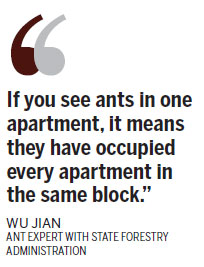Ant attack
Updated: 2012-06-06 09:56
By Liu Zhihua (China Daily)
|
|||||||||||

Do not underestimate these tiny insects, which look harmless. If you find ants in your home, help is underway. Liu Zhihua reports in Beijing.
 |
Awar has been declared on Beijing's rising ant population, which experts say poses a health risk because they can spread diseases, such as dysentery, typhoid and pneumonia. "Ants look tiny and safe, but they are as harmful as cockroaches and rats," says Wu Jian, an ant expert with State Forestry Administration.
"Most people are not aware of the potential harm they pose, and that is very dangerous."
More than 40 percent of houses in Beijing were infested with ants in 2011. In response, the Beijing health authority has launched a campaign to eliminate the pest.
Beijing resident Lu Li says she was overwhelmed when she found her apartment overrun by ants.
The apartment was in a community built in the 1990s, and Lu's family moved into it a couple of years ago.
Two years ago, Lu's son saw ants climbing into the living room through the pipes.
But Lu didn't pay much attention, as she thought she should not make too much fuss over a few ants looking for food.
But she soon found ants everywhere in her apartment.
"They are as mad as devils," Lu says.
"I saw them everywhere, from the kitchen to the living room, from the windowsills to the bedrooms."
Lu used almost every solution she could find from the Internet, such as spray, alcohol and insecticide, but they only provided temporary relief. Very soon, the ants were back again.
She also kept everything that contains sugar tightly wrapped up, but the ants were relentless.
"Can you imagine they were on the bed, on the desk, and even in our bowls and cups. It was extremely disgusting," Lu says.
When Lu read in the newspapers that the city government was providing free bait and guidance to repel ants in homes, she called the property management office in the community to register immediately.
The government has urged families with ant issues to register through their community office before June 15.
Free bait and specialists will be deployed to help eliminate the insect thereafter.
"An ant problem is not new in cities, but it has been overlooked for a long time," says Tong Ying, director of the Disinfection and Pest Control Section of Beijing Center for Diseases Control and Prevention.
There are more than 600 types of ants in China, and those that normally invade homes are yellow, red, brown or black in color, says Xu Zhenghui, an ant specialist with Southwest Forestry University.
"Ants love cities because of the warmer temperature, especially during winter. And ants have more food but fewer predators in cities," Xu says.
He adds ants are social insects, and those which are visible are adult female ants, known as worker ants.
Although most ants nest outside buildings, they often venture indoors in search of food.
Some of the ants are carried into homes through potted plants, as they nest inside the soil. Others, through pipes and their dwelling places, including cracks in furniture and walls, pipes and clothes.
In China, there are three kinds of common house ants, while the most prevalent type in Beijing are the yellowish brown ones.
"Those house ants are originally from the subtropical species and were brought into Beijing in the 1980s," Wu Jian says.
During the turbulent years of the "cultural revolution" (1966-76), many Beijingers were exiled to remote areas in South China.
When they were able to move back to Beijing in early 1980s, they carried almost everything they owned along with them, including used furniture and clothes, which were inhabited by ants.
"People were poor at that time, and were very economical," Wu says. "They kept everything without realizing that along with their things, they brought pests home, too."
In the mid 1980s, residents in some one-story houses of what is now Zhongguancun in Beijing reported ant problems, and Wu led their elimination.
"But the poisons used were not specially meant for ants. So, we didn't successfully terminate them," Wu says.
He elaborates that the pipes in buildings built before the 1990s were not properly wrapped up, making it very difficult to block ants from entering homes.
"If you see ants in one apartment, it means they have occupied every apartment in the same block," Wu notes.
"They pose great potential health risk in big cities like Beijing, particularly in hospitals."
Contact the writer at liuzhihua@chinadaily.com.cn.
Related Stories
Driving away the Five Poisonous Pests 2010-06-13 14:58
Preventing Vegetables from pests and diseases 2010-05-20 18:43
Catkins a pest? Oh, give it a rest 2007-05-11 18:41
Today's Top News
Rescuers race against time for quake victims
Telecom workers restore links
Coal mine blast kills 18 in Jilin
Intl scholarship puts China on the map
More bird flu patients discharged
Gold loses sheen, but still a safe bet
US 'turns blind eye to human rights'
Telecom workers restore links
Hot Topics
Lunar probe , China growth forecasts, Emission rules get tougher, China seen through 'colored lens', International board,
Editor's Picks

|

|

|

|

|

|





